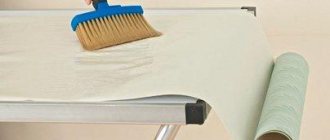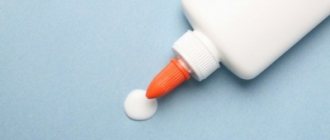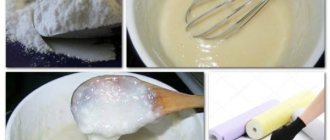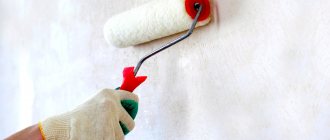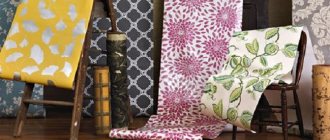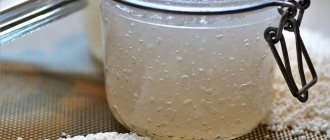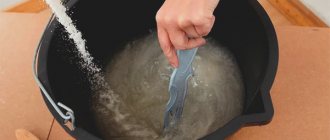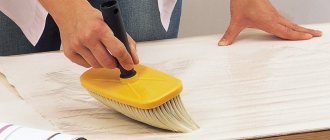Anyone at least once faced with the issues of selecting and storing adhesive compositions. They have different bases and, accordingly, expiration dates. These days, a variety of adhesives can be purchased in stores, and instructions for their use can be found in advance on the Internet. This is necessary in order to select the adhesive composition as accurately as possible to solve specific problems. But it happens that you can’t do everything in one day, and then the question of how to store the glue becomes relevant.
How long does diluted glue retain its properties?
Unlike glue, which does not require dilution, diluted analogues are stored for much less time. The duration of their storage depends on several factors. First of all, this is the composition and only then the temperature and humidity of the air, the container in which the substance is stored. How long do self-prepared pastes, tile and wallpaper adhesives retain their properties?
For non-woven wallpaper
Manufacturers usually indicate on the pack with the composition for non-woven wallpaper its expected consumption. However, it is not always possible to accurately calculate the amount of diluted substance, and it remains after work. Some people keep it for a while in case it suddenly comes in handy at home.
Diluted wallpaper glue of this type retains its properties for no more than 1.5 weeks if it is stored in a cool room, and about 7 days if the container with it was in a room where the air temperature is 18–24°C. Some people claim that the adhesive composition for non-woven wallpaper was stored for 15 days without losing its qualities. It all depends on the amount of preservatives in the product. If the glue does not emit an unpleasant odor, but has only slightly thickened, it can be safely used, diluting it with water if necessary.
For vinyl wallpaper
The adhesive composition for vinyl wallpaper in diluted form cannot be stored for a long time. No matter how tightly the container with it is closed, over time processes occur in it that lead to a deterioration in its performance. Having prepared wallpaper glue, it is recommended to use it as quickly as possible. It is difficult to say how long it will last without losing its original properties. The product may deteriorate on the second day, or it may be perfectly preserved for 2 weeks. Experienced craftsmen claim that vinyl wallpaper adhesive can be stored for no longer than 1.5 weeks.
For gluing tiles
Tile adhesive compositions are not subject to long-term (longer than 3-4 hours) storage. That is why their manufacturers recommend using the mixed mass quickly; with each subsequent hour its suitability for use decreases. You need to prepare the tile solution in small portions.
What to do if at the end of the working day there is a lot of mixed tile adhesive left? If there is any other work that requires the use of an adhesive composition, it is better to use the remainder, for example, to seal open grooves, holes, or level the surface for laying tiles. Otherwise, it is wiser to throw away the remaining glue, because within a few hours it will lose the necessary qualities.
Sometimes, in order to preserve tile adhesive, they resort to various tricks. You can try the following popular way to extend the life of tile adhesive:
It will not be possible to preserve the properties of tile adhesive using this method for more than a day. The adhesive solution, even without access to oxygen, hardens strongly, and when you try to break it with a mixer, hard lumps form, and after “reanimation” the glue turns out to be non-plastic, loose and quickly releases water.
Homemade paste
This gelatinous adhesive, homemade from starch or flour, is used for various purposes, for example, for gluing wallpaper or making crafts from papier-mâché and fabric. In the past, it was often used to seal wooden window frames to insulate a living space for the winter.
The main advantages of homemade paste are its natural composition and low cost. The main disadvantage is the short shelf life. If the manufacturers of ready-made glue took care of its durability by adding special chemical components to the composition of their products, then this is impossible when preparing the solution yourself.
Acrylic sealants
This type of sealant is used to seal seams and cracks between concrete or stone surfaces. Acrylic sealants retain their elasticity for a fairly long time, the surface of the sealant is well covered with various coloring substances, and acrylic sealants are also impervious to strong vibration.
Acrylic-based sealants do not contain solvents, are most effective for use both inside and outside buildings, and are mainly used for sealing cracks with slight deformation.
Acrylic sealants have excellent adhesion to concrete, brick, wood, plaster, etc., and therefore lend themselves well to painting and plastering.
The described sealing materials form a film when dried within 15 minutes. Once applied, acrylic sealants are insensitive to temperatures ranging from -25°C to +80°C and have good resistance to light and ultraviolet rays.
Since acrylic sealants do not contain highly toxic substances, they do not pose any harm to human health; when working with them, you do not need to use special gloves or a respirator.
Sealants are sold in standard packaging (tubes) of 300-500 ml. The sealant must be protected from frost during storage. The shelf life of the sealant at an average temperature of +20°C is at least 1 year.
How to store prepared glue so that it does not dry out and spoil?
The length of time the diluted glue retains its working properties largely depends on how it is stored. Different adhesive compositions have different storage conditions. If you ignore them, any solution, no matter how long its shelf life, will quickly deteriorate. For convenience, detailed information on how to properly store different types of glue is presented in the table:
| Type of adhesive composition | Storage conditions | What to do with the glue before use | |
| Temperature | View | ||
| Wallpaper | Reduced, but not minus (for example, in the refrigerator) or room temperature (18–24°C). The lower the temperature, the longer the glue retains its properties. | The glue should be stored in a tightly closed container, removing foreign objects (rollers, stirring tools, brushes) from it. If it does not have a lid, you can cover it with polyethylene so that no air gets inside. | The solution must be mixed thoroughly. You cannot mix freshly prepared glue or a product with a different composition into it. |
| Tiled | Room | Before removing the remaining glue until the next use, so that it does not lose its properties, you need to fill it with cold water, mix the mixture with a mixer, and then tightly close the container with the adhesive composition with a lid or plastic wrap. | Before use, drain the water, stir the settled mass with a mixer, add the dry mixture and mix a new portion of glue. |
| Homemade paste | Not higher than 18˚C | It is recommended to store the remaining paste in a tightly closed container, for example, in the refrigerator. If you want to preserve its properties for a long time, you can add a small amount of a preservative component, for example, alcohol or vodka. | If the paste has thickened, it is recommended to dilute it with warm water to the required consistency before use. |
How do you know if the glue is unsuitable for the job?
Signs that the adhesive composition is unsuitable for further use:
- Changes in consistency (becomes too liquid or, on the contrary, thick), shade and smell (harsh, unpleasant).
- Deterioration of adhesive ability. If you take a little glue and squeeze it between your fingers and it doesn't stick to the skin, it means it's gone bad.
- Foreign inclusions.
- Formation of lumps.
- Delamination.
I hope that the material presented is sufficient to correctly take into account the shelf life of any glue. The next video is about expired glue.
Principles of using wallpaper glue
To obtain a high-quality adhesive solution, it must not only be chosen correctly, but also mixed well. You should always study the instructions from the manufacturer, which indicate the required ratio of components.
There should be no lumps left in the finished solution; it must be used within a certain period of time so that it retains its properties. It is advisable to select a specialized mixture for the selected type of wallpaper. So there are subtleties in diluting different adhesives. For example, how to dilute glue for non-woven wallpaper is somewhat different from working with glue for paper and vinyl.
It is advisable to select a specialized mixture for the selected type of wallpaper.
Breeding method
The technology for diluting glue is very simple and approximately the same for all brands. The required amount of clean cold water is poured into an enamel or plastic container with high edges. Lumps may form in water that is too warm. Dry glue is poured into the water in a thin stream, stirring continuously.
It is better to use a special mixer to dilute the glue.
For this purpose, it is convenient to use a special mixer attachment mounted on a conventional drill. If you don’t have one, you can simply stir with a wooden stick - but this, of course, will not be as effective. Then the solution is allowed to stand for several minutes and stirred again. The glue is ready.
How long can diluted wallpaper paste be stored? kakhranitedy.ru
What is the shelf life of wallpaper glue?
As a rule, it is thrown away, but it makes sense to leave some amount of glue so that you can glue the loose corners or joints. The glue should be placed in a glass jar, closed with a nylon lid and placed in the refrigerator. There it can be stored for almost unlimited time.
Wallpaper adhesive produced by the Moscow plant ProMASTER is presented in several versions, which differ in terms of chemical composition and properties. Our product is manufactured in accordance with German BASF technology. This formulation guarantees a number of significant technological advantages:
Where can I use diluted wallpaper glue? What is the shelf life of diluted wallpaper glue?
There is a lot of wallpaper glue that has been diluted, where it can be used and how long it can be stored in a diluted state.
The shelf life of wallpaper glue diluted (with water) depends on the glue itself (wallpaper glue varies), as well as on the manufacturer.
But in any case, information about the shelf life of dry and diluted glue is on the packaging, here is a photo
Most often, wallpaper glue is stored for 7 to 10 days (diluted), but in a tightly closed container.
From personal experience I can add that I extended the shelf life of the glue to 14 days, stored it in a jar (glass) with a tightly closed nylon lid, on the bottom shelf of the refrigerator.
Then I took it out and left it in a room at room temperature for several hours (I don’t recommend heating the glue).
That's it, I didn't glue wallpaper on it, but I used it as a primer for wallpaper, everything is fine.
Of course, it is better to dilute the right (necessary) amount; diluted glue does not last long.
But if this happens, you can dilute it with water and prime the surfaces for wallpapering.
But you cannot leave the surface without finishing (finishing) for more than 2 days; dust will settle on the surface and you will have to either remove the dust or re-prime it.
This refers to premises that are undergoing renovation.
If the premises are not dusty, then a maximum of 5 days and then you need to start finishing.
You can also add glue, for example, to plaster or alabaster, they will harden more slowly and plus their elasticity will increase.
You can use it in a cement-sand mortar, it will also improve its elasticity and partially adhesion.
If nothing fits, close the container tightly and put the glue in the refrigerator to extend its shelf life.
You can use it in a cement-sand mortar, it will also improve its elasticity and partially adhesion.
How long can you store diluted wallpaper glue?
How long can diluted wallpaper paste be stored?
I store the diluted glue at t+23-25° for 2 days, because then the smell appears and the consistency deteriorates, this has already been tested, even if the glue is stored longer in a cold place at t+3 +10°, then no more than 5 days, but Even better, if you dilute the glue in the required amount, then there will certainly be no reason to worry about storing it. Good luck with your repair.
You can't generalize everything, generalize all wallpaper pastes. After all, each manufacturer has its own recipe for making glue. Some people add more preservatives, others less. It's best to test the glue yourself. To do this, just smell the glue that has been standing for a long time. If there is no unpleasant odor, then you can safely use this glue - it has been tested many times from our own experience. If there is an unpleasant smell, feel free to throw it away.
Storing tile adhesive
The composition used to glue tiles must be stored in special rooms designed to conserve building materials. These places are usually equipped with good ventilation and have low air humidity.
Manufacturers of formulations pay a lot of attention to the issues of their storage. Various hydrophobic components are added to them, which allow the adhesives to maintain their qualities for a long time. Also, to extend shelf life, adhesive materials are packaged in special sealed multilayer bags. But even in this case, tile adhesive should be stored only in a dry room .
On average, the shelf life of tile adhesive does not exceed 6 months. Then processes begin that change its composition, and its adhesive qualities are lost by 5–10% every month. Therefore, it is necessary to check the release date, which is usually stamped on the packaging, before purchasing.
When adhesive compositions are stored incorrectly - in conditions of high humidity or at sub-zero temperatures - it is better not to buy them. Most likely, they have hardened and become unusable. Most often, low-quality goods can be purchased on the market. Large construction supermarkets have special storage areas for such materials, so it is better to buy the mixture in such places.
Each building mixture has its own shelf life. They depend on various reasons:
- chemical composition,
- like,
- manufacturer,
- packaging sizes.
But in any case, the dry mixture is stored longer than the solution.
Some craftsmen even use expired adhesives. They add some of the fresh solution to them and add water. After thorough mixing, tiles are placed on this solution. In this case, you can get a lottery in which with a 50% probability the tile will either disappear or not.
You can also restore the adhesive properties of an expired mixture by adding special latex components. They are not cheap, but they give a good effect. This method of “reanimation” is only suitable for dry adhesive composition that has not yet completely hardened.
But still, it is better to buy fresh adhesive in order to be absolutely sure of the quality of your work.
Shelf life
The shelf life of the tile mixture depends primarily on its type. At the moment, there are 2 types of finished product:
- dry mixture, for the preparation of which you need to dilute the mixture with water
- a completely ready-to-use product.
The dry mixture is very demanding on storage conditions and is sensitive to temperature changes and high air humidity. This mixture should be stored in a heated room, with an average humidity of no more than 60-70%. The mixture should not be exposed to direct sunlight. The shelf life under such conditions usually ranges from 9 months to a year.
The product, completely ready for use, is not so sensitive to air humidity. But temperature changes can have a negative effect on such a composition. It is better to store this mixture at above-zero temperatures in a dark room. The shelf life of liquid glue is indicated by the manufacturer and can range from 6 months to 2 years. If possible, use mastic immediately after opening. The mixture can be stored for no longer than 1-2 months, after which it is not recommended to use it.
How to cook
How to prepare glue? The manufacturer took care of this, so each package has detailed instructions and even drawings. Usually the whole process comes down to adding a powdery mass to water. The composition is thoroughly mixed and after that it becomes suitable for work. How long diluted wallpaper glue will be stored is indicated on the packaging. This indicator depends on the type of paste and manufacturer. Therefore, before diluting the mixture, you need to read the instructions so as not to spoil the glue.
Considering all that has been said, you can choose a good paste option that will reliably hold any type of wallpaper. And you shouldn’t waste money on this, since subsequent repairs will cost much more. And if it’s difficult to choose a specific option, you can contact a consultant in the store, he will tell you what is better to choose.
Famous manufacturers
Which brand of wallpaper glue is most often found in hardware stores?
- "Cleo." This is a French manufacturer whose products have firmly established themselves in our market. The substance contains elements that can protect walls from mold formation. There are many varieties of this wallpaper paste. For example, “Cleo Ultra” - it is suitable for glass wallpaper. It is also absolutely safe for people - if you are going to do repairs in the nursery, then take a closer look at it. "Cleo Extra" is ideal for fabric. There is also a special “Cleo” for processing wallpaper at the joints - it is suitable for any type.
- "Kelid." Also a French company, but the products cost slightly less. This company produces wallpaper glue for all materials. A special feature is slow drying. Some will find this a minus, while others will see it as a plus. After all, within ten minutes after applying the substance, unevenness can be corrected.
- "Methylane" is a wallpaper adhesive in the same price category as Cleo. Only it is produced in Germany. There are separate products for specific types, as well as universal wallpaper glue.
We recommend: How to choose glue for foam plastic and use it correctly?
French universal glue
Universal wallpaper adhesive is used for all types of fabrics. The amount of liquid depends on the heaviness, density, and texture of the material. Weak dilute solutions are used for paper materials. They are poorly stored, capable of separation, require regular stirring, and turn sour at temperatures above 20 degrees.
How long you can store diluted thick wallpaper glue depends on the conditions. At room temperature no more than three days. Without a lid for up to a day, periodically removing the drying top layer. It can be stored in the refrigerator for up to 15-20 days, provided that you use glass containers with a tight lid.
You need to transfer the prepared solution into a storage container and put it in a cool place immediately after finishing pasting the walls. There is no need to wait for the completion of work or the moment of cleaning.
Required tools and materials
Before you start diluting wallpaper glue, you should prepare the tools and materials that you will need for the work. The list includes the following tools and materials:
- The glue itself;
- Container for diluting the mixture with water (basin, bucket);
- Water, take clean water at room temperature;
- Tools for mixing components: construction mixer, stick, drill with mixing attachment.
Before you start diluting wallpaper glue, you should prepare the tools and materials that you will need for the work.
What determines glue consumption?
To prepare the required amount of solution at once, you should ensure that the required amount of the mixture is available in advance. You can understand how much product you will need based on the average consumption indicated by the manufacturer. It varies depending on the type of adhesive solution. A number of factors influence the consumption rate:
It is better to take the mixture with a reserve so as not to make a mistake.
To prepare the required amount of solution at once, you should ensure that the required amount of the mixture is available in advance.
How long can diluted glue be stored?
To preserve all the properties of the adhesive, you must use it on time. Therefore, before diluting wallpaper glue, calculate how much it will be needed for the room.
To do this, you need to understand how long diluted wallpaper glue is stored. There is no definite answer, because adhesives differ. Or it may be necessary to complete the gluing process before all the canvases are glued, or the amount of product is incorrectly calculated.
Then, to avoid using a spoiled solution, evaluate its condition, there should be no unpleasant odor, and the mass should not change in appearance. They also conduct a quality test by gluing a small piece of wallpaper; if the fixation is good, you can continue to work with this product.
It is better to store the solution in its finished form by covering the container with plastic wrap and a lid; this will increase the service life to several days.
They conduct a quality test by gluing a small piece of wallpaper; if the fixation is good, you can continue to work with this product.
How to properly glue non-woven wallpaper?
How to glue non-woven wallpaper?
- Apply glue to the entire area of the wall from the corner to the first marking strip. ...
- Glue the first sheet so that it lies clearly along the line of the marking strip.
- the wallpaper
well , moving the roller from top to bottom, as well as from the center of the strip to the edges. ... - Wipe off excess glue with a foam sponge.
Interesting materials:
Is it possible to work without a patent now? Is it possible to film an employee at work? Is it possible to lay off an employee with a child under 3 years old? Is it possible to sleep at work during your lunch break? Is it possible to study for a master's degree and work in Kazakhstan? Is it possible to assign an employee a 24-hour shift? Is it possible to get a person a job without registration? Is it possible to get a job as a massage therapist without a medical education? Is it possible to get a job with two work books? Is it possible to get a job with a criminal record?
"Quelyd" France
Quelyd is a popular wallpaper adhesive among professional builders and repairmen. Easy to spread, sets quickly, adheres to different surfaces - plaster, concrete, wood. Used for extra heavy and thick vinyl wallpaper. An unusual point - it tolerates mixing with PVA very well. This is actively used by professional repairmen when working with heavy, complex canvases.
Diluted wallpaper glue is stored at +1-8 degrees for up to a week. When adding PVA it increases to three weeks. The shelf life of the material in its original packaging is not limited by time. It retains its adhesive properties for 10-20 years if stored in a dry, dark place at temperatures up to +20 degrees.
Wallpaper glue Metylan
Methylane is used for paper and non-woven wallpaper. In addition to modified starch, it contains antifungal components, like disinfectants. It is small granules. Quickly dissolves in water and swells. After dilution it has a pink color and sets as it dries.
Features of storing wallpaper glue
A significant drawback is the short shelf life. The dry product in the package is stored for only 2 years. Similar domestic and foreign species can last for decades in dry places. The diluted solution quickly sets and dries. In a closed jar without access to oxygen, it is stored in the refrigerator for up to 10 days. We do not recommend diluting large quantities for future use. It's easy to do this again if necessary.
Pros of Metylan glue:
- color indicator;
- adhesion to cement, concrete, wood;
- easy to divorce;
- dissolves quickly;
- has antifungal additives.
Minuses:
- dries in a short time;
- short shelf life of dry wallpaper glue;
- May conflict with wallpaper painting and requires proper drying.
The first sign of damage to diluted Methylane wallpaper glue is the loss of the indicator. The pink color becomes lighter and a completely transparent solution is obtained.
Tips you may need when mixing glue
Experts with experience have identified some simple techniques that will help you get the desired result. The recommendations are as follows:
To improve adhesion, it is better to deviate somewhat from the manufacturers’ instructions and reduce the amount of water by 10%.
To ensure that the wallpaper fits tightly to the wall and does not fall off the next day, special attention is paid to the choice of adhesive. It is not recommended to resort to universal formulations; it is better to take specialized ones. Dilute the product carefully and step by step so that the mass is homogeneous and without lumps.
Types of Moment adhesives
The Moment line of polyurethane adhesives is produced by the manufacturer Henkel. According to user reviews, the demand for this series is the highest among its analogues. The following types of contact adhesives are available for sale:
- “Moment No. 1 Classic” (Universal). The glue is inexpensive and suitable for most known materials. It has a high level of adhesion, thickness, and fast drying.
- "Moment Gel". This product has a gel structure, is a type of superglue, and is available not only in tubes, but also in canisters.
- "Moment Crystal". An absolutely transparent composition based on polyurethane, used in everyday life, repairs, and construction.
- "Moment Marathon". Most often purchased for shoe repair, widely used by craftsmen. Very resistant to environmental factors.
- "Moment 88 Extra Strong." This product guarantees the highest adhesive strength and is not afraid of water or frost.
- "The 60 second moment." One-component adhesive characterized by fast drying. Convenient for use on vertical bases.
There are also specialized “Moment” products on sale - for rubber, plastic, boats and PVC, cork. Universal adhesive “Moment Gold Standard” is suitable for any material.

